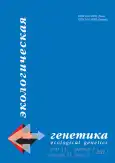R577X-полиморфизм альфа-актинина-3 в популяциях человека на Северо-Востоке Азии
- Авторы: Малярчук Б.А.1, Деренко М.В.1, Денисова Г.А.1
-
Учреждения:
- Институт биологических проблем Севера Дальневосточного отделения РАН
- Выпуск: Том 15, № 1 (2017)
- Страницы: 50-56
- Раздел: Статьи
- URL: https://journals.rcsi.science/ecolgenet/article/view/6302
- DOI: https://doi.org/10.17816/ecogen15150-56
- ID: 6302
Цитировать
Полный текст
Аннотация
Замена C→T в локусе rs1815739 гена альфа-актинина-3 приводит к терминации синтеза белка в аминокислотной позиции 577 (замена R577X). Предполагается, что дефицит этого белка в мышечных волокнах повышает выносливость и способствует адаптации человека к холоду. В настоящей работе приводятся результаты исследования полиморфизма локуса rs1815739 в популяциях коренного (чукчи, коряки, эвены) и пришлого (русские) населения Северо-Восточной Азии. Обнаружено понижение частоты варианта rs1815739-T в популяциях Северо-Восточной Азии. Аналогично по результатам анализа экзомного полиморфизма у коренного населения этого региона наблюдается пониженная частота гаплотипа, включающего в свой состав аллель rs1815739-T. Полученные данные не поддерживают гипотезу об адаптивном значении локуса rs1815739.
Ключевые слова
Полный текст
Открыть статью на сайте журналаОб авторах
Борис Аркадьевич Малярчук
Институт биологических проблем Севера Дальневосточного отделения РАН
Автор, ответственный за переписку.
Email: malyarchuk@ibpn.ru
д-р биол. наук, зав. лаборатории генетики
Россия, МагаданМирослава Васильевна Деренко
Институт биологических проблем Севера Дальневосточного отделения РАН
Email: mderenko@mail.ru
д-р биол. наук, главный научный сотрудник, лаборатория генетики
Россия, МагаданГалина Алексеевна Денисова
Институт биологических проблем Севера Дальневосточного отделения РАН
Email: gad@ibpn.ru
канд. биол. наук, старший научный сотрудник, лаборатория генетики
Россия, МагаданСписок литературы
- Mills M, Yang N, Weinberger R, et al. Differential expression of the actin-binding proteins, alpha-actinin-2 and -3, in different species: implications for the evolution of functional redundancy. Human Molecular Genetics. 2001;10:1335-1346. doi: 10.1093/hmg/10.13.1335.
- North KN, Yang N, Wattanasirichaigoon D, et al. A common nonsense mutation results in alpha-actinin-3 deficiency in the general population. Nature Genetics. 1999;21:353-354. doi: 10.1038/7675.
- Alfred T, Ben-Shlomo Y, Cooper R, et al. ACTN3 genotype, athletic status, and life course physical capability: meta-analysis of the published literature and findings from nine studies. Human Mutation. 2011;9:1008-1018. doi: 10.1002/humu.21526.
- Yang N, MacArthur DG, Gulbin JP, et al. ACTN3 genotype is associated with human elite athletic performance. American Journal of Human Genetics. 2003;73:627-631. doi: 10.1086/377590.
- MacArthur DG, Seto JT, Raftery JM, et al. Loss of ACTN3 gene function alters mouse muscle metabolism and shows evidence of positive selection in humans. Nature Genetics. 2007;39:1261-1265. doi: 10.1038/ng2122.
- Bramble DM, Lieberman DE. Endurance running and the evolution of HomO. Nature. 2004;432:345-352. doi: 10.1038/nature03052.
- MacArthur DG, North KN. A gene for speed? The evolution and function of alpha-actinin-3. Bioessays. 2004;26:786-795. doi: 10.1002/bies.20061.
- Schlebusch CM, Skoglund P, Sjödin P, et al. Genomic variation in seven Khoe-San groups reveals adaptation and complex African history. Science. 2012;338:374-379. doi: 10.1126/science.1227721.
- Amorim CE, Acuña-Alonzo V, Salzano FM, et al. Differing evolutionary histories of the ACTN3_R577X polymorphism among the major human geographic groups. PLoS ONE. 2015;10(2): e0115449. doi: 10.1371/journal.pone.0115449.
- Wang S, Lewis CM, Jakobsson M, et al. Genetic variation and population structure in native Americans. PLoS Genetics. 2007;3(11): e185. doi: 10.1371/journal.pgen.0030185.
- Hofer T, Ray N, Wegmann D, Excoffier L. Large allele frequency differences between human continental groups are more likely to have occurred by drift during range expansions than by selection. Annals of Human Genetics. 2009;73:95-108. doi: 10.1111/j.1469-1809.2008.00489.x.
- Rasmussen M, Anzick SL, Waters MR, et al. The genome of a Late Pleistocene human from a Clovis burial site in western Montana. Nature. 2014;506:225-229. doi: 10.1038/nature13025.
- Reich D, Patterson N, Campbell D, et al. Reconstructing Native American population history. Nature. 2012;488:370-374. doi: 10.1038/nature11258.
- Eynon N, Ruiz JR, Femia P, et al. The ACTN3 R577X polymorphism across three groups of elite male European athletes. PLoS ONE. 2012;7(8):e43132. doi: 10.1371/journal.pone.0043132.
- Untergasser A, Cutcutache I, Koressaar T, et al. Primer3 – new capabilities and interfaces. Nucleic Acids Research. 2012;40:e115. doi: 10.1093/nar/gks596.
- Clemente FJ, Cardona A, Inchley CE, et al. A selective sweep on a deleterious mutation in the CPT1A gene in Arctic populations. American Journal of Human Genetics. 2014;95(5):584-589. doi: 10.1016/j.ajhg.2014.09.016.
- Pagani L, Lawson DJ, Jagoda E, et al. Genomic analyses inform on migration events during the peopling of Eurasia. Nature. 2016;538:238-242. doi: 10.1038/nature19792.
- Tamura K, Peterson D, Peterson N, et al. MEGA5: molecular evolutionary genetics analysis using maximum likelihood, evolutionary distance, and maximum parsimony methods. Molecular Biology and Evolution. 2011;28:2731-2739. doi: 10.1093/molbev/msr121.
- Excoffier L, Laval G, Schneider S. Arlequin (version 3.0): an integrated software package for population genetics data analysis. Evolutionary Bioinformatics Online. 2007;1:47-50. PMCID: PMC2658868.
- Excoffier L, Laval G, Balding D. Gametic phase estimation over large genomic regions using an adaptive window approach. Hum Genomics. 2003;1:7-19. PMCID: PMC3525008.
- Pasqua LA, Bueno S, Matsuda M, et al. The genetics of human running: ACTN3 polymorphism as an evolutionary tool improving the energy economy during locomotion. Annals of Human Biology. 2016;43(3):255-260. doi: 10.3109/03014460.2015.1050065.
Дополнительные файлы






